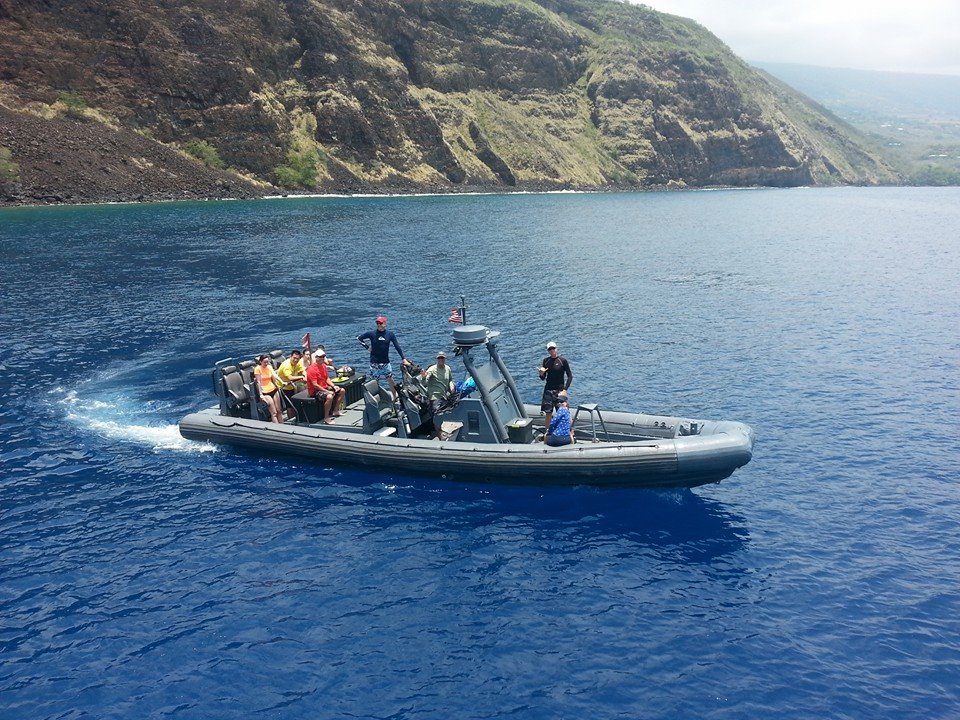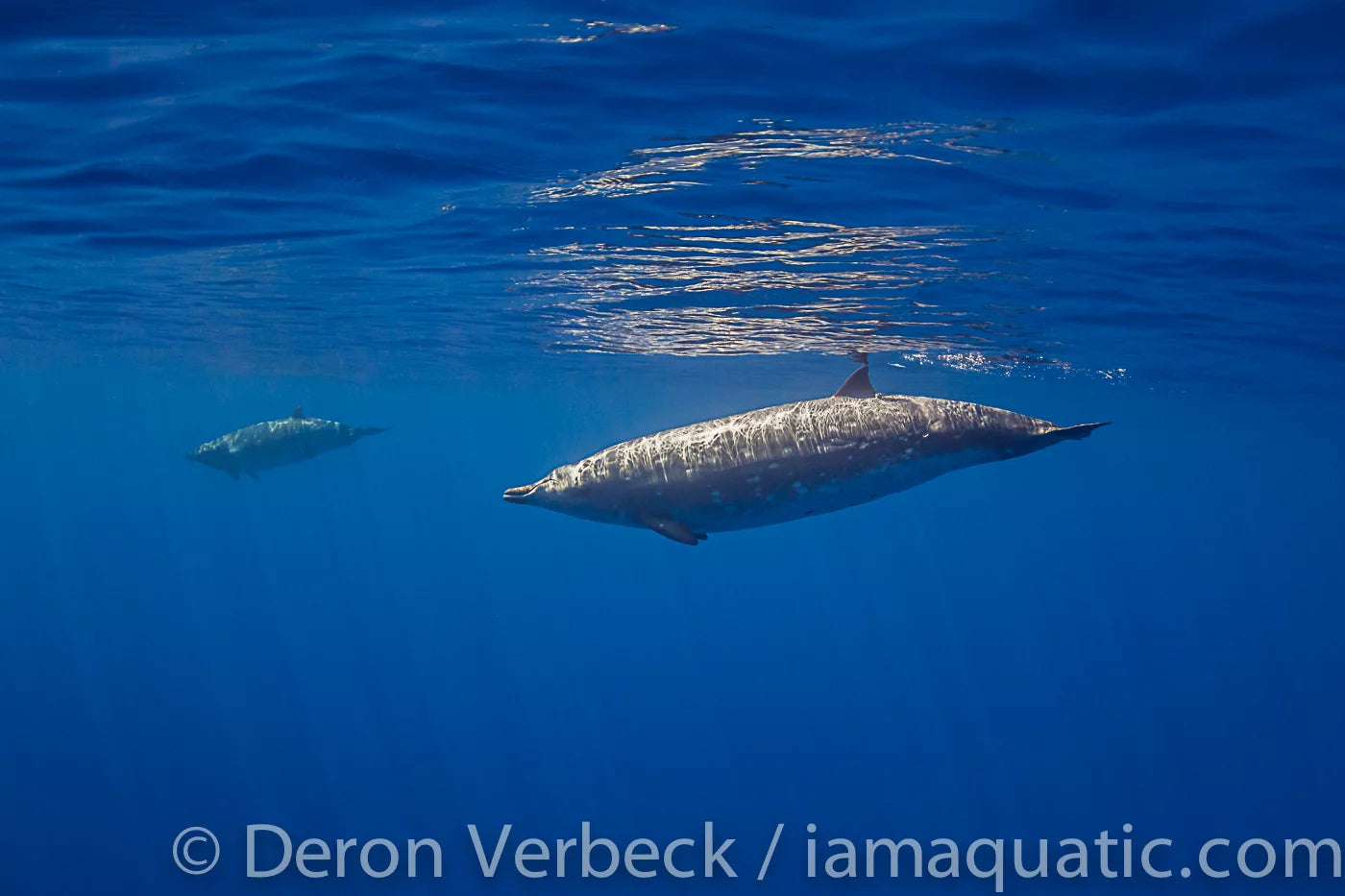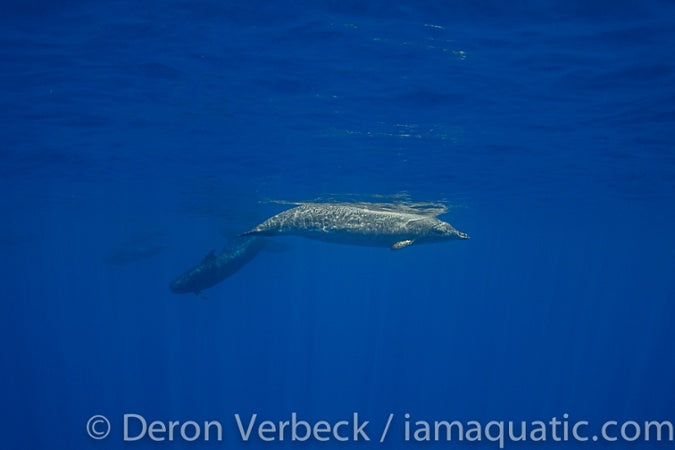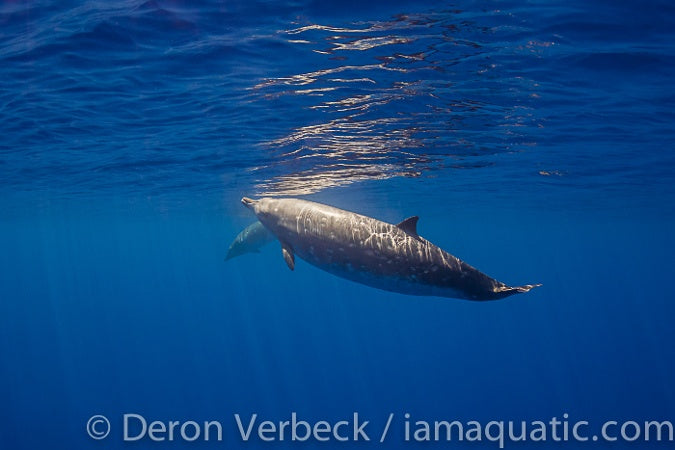
Freediving Encounter with Rare Blainville’s Beaked Whale
Sitting on the deck of my workboat the Ocean Warrior. We were waiting for our three guests for the day trip to arrive and I get a call from a fisherman friend Mark that there are Pilot Whales out offshore mingling with some Bottlenose Dolphins and that they’re behaving strangely. So as soon as our people show up we launch and head offshore.

We find the Pilot Whales right where my friend said they would be and sure enough they are acting strange. Now strange behavior for a Pilot Whale is anything other than swimming in a straight line or logging (resting) on the surface. These animals were zig zagging down the coast, turning around and heading the opposite direction then turning back, just not usual behavior.
One thing I didn’t see were the Bottlenose Dolphins so I figured they left. So we tried our usual routine of slipping into the water outside the group of whales and having them swim by which they did. We climbed back on the boat and my partner Brett said my phone is ringing off the hook. I look to see who it is and it’s a different fisherman friend Jeff that had called, but didn’t leave a message. I called him back and he said he had just passed a group of “beaked” whales heading south and inside of where we were. So we moved in and started the search.

Now “beaked” whales can mean one of two semi-common whales here in Kona, either a Cuvier’s Beaked Whale or a Blainville’s Beaked Whale. Both of which are extremely deep divers and extremely long breath holders. We are talking into the ten thousand feet range and nearly two hours of breath hold. This makes re-sighting rates very low, but it was worth a try.
We moved in and headed south for a couple of miles. As we were cruising Mark sent me a text asking what I was looking for. I texted him “beaked” whales and put my phone down to continue searching for the whales. We drove around for about ten or fifteen minutes before I checked my phone. I had a text from Mark saying “they are right here!”. We were a couple of miles away from where he was and to the north of us so we turned and ran back.
We found Mark and he was pointing behind him and out, so we followed the line he was directing us and ran back into the Pilot Whales. Well low and behold the “beaked” whales where with the Pilot Whales. This is when I got a good look and confirmed they were Blainville’s Beaked Whales. There were four of us partially ready to get back in the water so we scrambled to get the rest of our gear on.
Brett slowly moved the boat closer to the group of whales as we continued to gear up. We could see the Blainville’s intermingling with the Pilots and for me this was a great thing. The two other times I’ve seen the Blainville’s with the Pilots they were very curious of the boat and people and would approach us. So four of us slipped into the water and slowly moved away from the boat.
Sure enough one of the Blainville’s got curious and swam over to us to check us out. I had my group stop and let the animal approach. I could tell it was a juvenile because of the lack of body scares from Cookie Cutter Sharks. It kept its distance, but came close enough for me to get ID shots. I’ll send the images I get off to Cascadia Research Collective for identification in their catalogs. If the animal is a new animal that has never been seen before then it’ll be entered and given an ID number.

I’ve donated many images of marine mammals to Cascadia over the years in hopes they can help with the conservation and perpetuation of some of the rarest animals on our planet that live off of the Kona coast. As the animals moved off in a southerly direction I had my photographer guest move back to the boat. We repositioned the boat away from the Pilots and waited to see if the Blainville’s were still with them, they were.
We slid into the water and swam away from the boat. When I thought we were far enough away I had my guests stop and wait. Sure enough we were enough to wet the appetite of the Blainville’s and one (an adult) approached us. I focused my camera in its direction as it swam on the surface towards us. Then I look down into the deep and the other two animals were literally swimming straight up out of the deep at us. They split us, two going one direction and one going the other.
The two adult animals swam towards one of my guests so I swam in that direction. They circled him and then swam towards me and crossed right in front of me. This allowed me to capture one of the best sequence shots of these animals I’ve ever gotten. They slowly swam ahead of us both animals literally stopping to wait for us to catch up, as soon as we would the animals would look back at my guest and me and slowly swim ahead.
I believe truly believe they were not fleeing us, but swimming with us. After a few minutes of this they dove into the abyss. These animals have an interesting diving pattern. As an ex-competitive breath hold diver (freediver) it is very interesting to see via Cascadia’s research papers how exactly these animals prepare for a deep dive. They will surface from a deep dive and breath on the surface for a certain amount of breaths then drop down to a hundred plus feet and cruise for ten to fifteen minutes. They will resurface and do a similar pattern for six to eight times. Then they are ready for another deep dive. As a competitive diver we would do very similar breathing routines.

For me I would breath on the surface for seven minutes then drop down a line to sixty feet and hang there for three to four minutes. I’d return to the surface and repeat the breathing and diving a few times before a really deep dive. The breathing is saturating my tissue with oxygen and diving is acclimating my body to depth and breath holding. So basically I am mimicking the whales behavior to prep for a deep dive. Of all the whale species I relate more to the “beaked” whales than any other. I just wish I could dive as deep.
We did several other jumps with these amazing animals. One in particular was great because we didn’t see the Blainville’s on the surface when we entered water. We thought they may have left so we were just going to hang with the Pilots when the group of three animals swam up out of the deep and right in front of us allowing me to capture a rare moment of two different species intermingling. This behavior has not been very well documented so I feel privileged and honored to be able to have captured this. My hopes are to help with the research of these amazing creatures I share the ocean environment with. I hope in the future Cascadia Research and PuraKai Clothing can team up to help preserve our very rare and extremely valuable ocean creatures that live here in Hawaii.






1 comment
Here and so too happens:)
novopet
Leave a comment
This site is protected by hCaptcha and the hCaptcha Privacy Policy and Terms of Service apply.